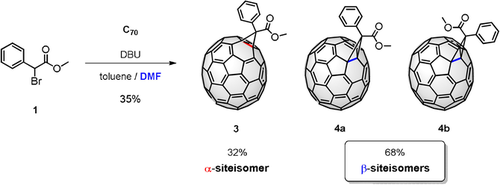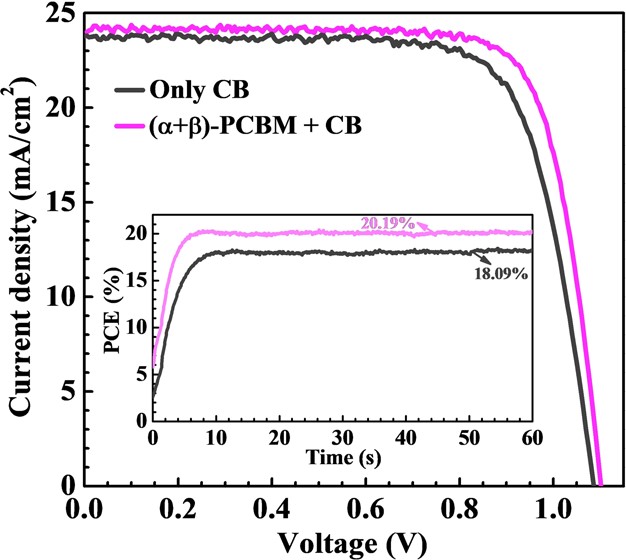5. PHOTOVOLTAICS
5.1. Perovskite Solar Cells (PSCs): Synthesis of new materials and devices
Hybrid Organo-Inorganic Lead Halid Perovskites Solar Cells (PSCs)
Since its first use as light absorber in a sensitized solar cell by Miyasaka and co-workers, organic-inorganic methylammonium (MA) lead halide MAPbX3 (X = I, Br) perovskites have experienced a scientific research blast for photovoltaic applications. Organometal trihalide perovskites exhibit exceptional intrinsic properties such as light absorption from visible to near-infrared range, high extinction coefficient, long electron-hole diffusion lengths, a direct band gap as well as high charge carrier mobilities, among others. Furthermore, the perovskite material is relatively versatile and its electronic properties can be widely tuned by cationic or anionic substitution. The ambipolar behavior of the perovskite allows its combination either n-i-p or p-i-n configurations with electron transporting (ETMs) and/or with hole-transporting (HTMs) materials.
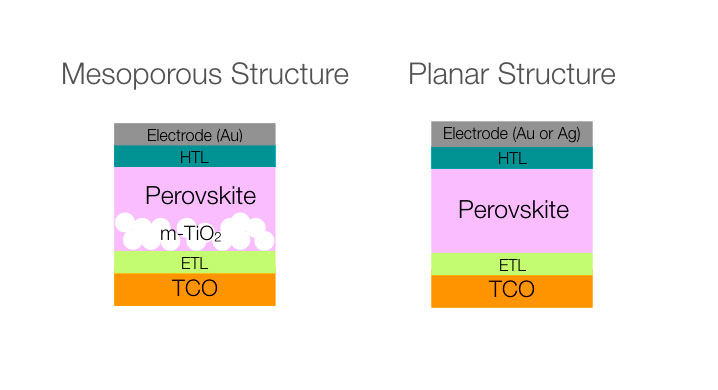
Hole-Transporting Materials
We have prepared small-molecule hole transporting materials based on tetraphenylethene derivatives, decorated with electron-donating diphenylamine. Diphenylamines derivatives are one of the most used moieties in HTMs because of their three-dimensional propeller structure, which is beneficial for improving solution processability, strong electron-donor properties and excellent hole-injection and transport properties via radical cation species. The solar cells show light-to energy conversion efficiencies as high as 11% under standard measurement conditions without the need of additional dopants.
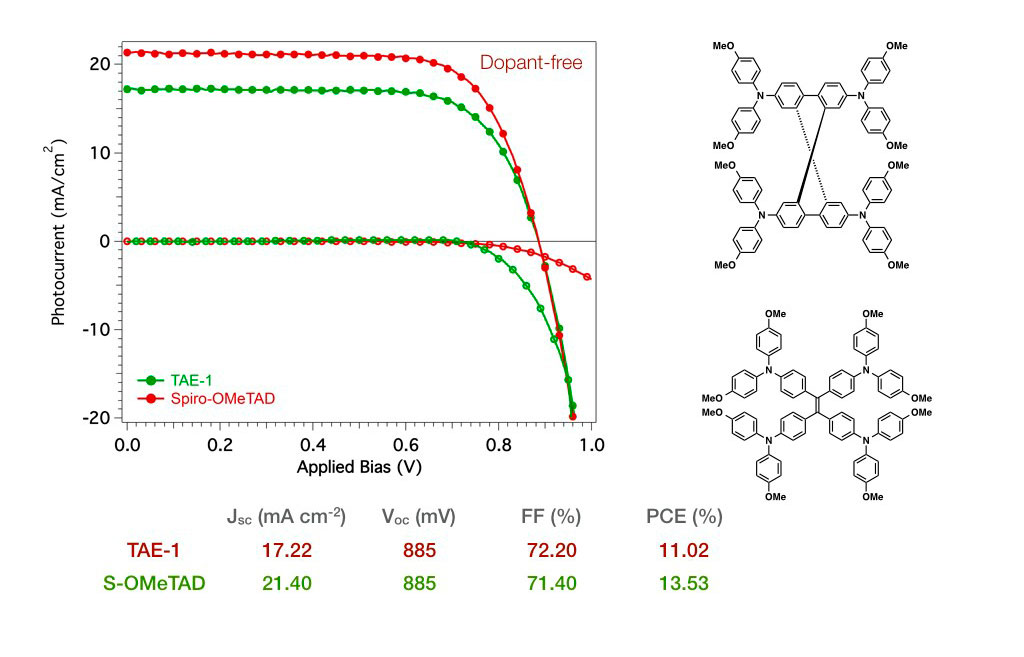
We have also focused on the development of a new family of ease to prepare HTMs based on a benzo[1,2-b:3,4-b´:5,6-b´´]trithiophene (BTT) as a central core endowed with p-methoxydiphenylamine (BTT-1), p-methoxydiphenylamine-substituted carbazole (BTT-2) and p-methoxytriphenylamine (BTT-3). Power conversion efficiencies in the range of 16 % to 18.2 % were achieved under AM 1.5 sun with the three derivatives tested on solution processed lead trihalide perovskite based solar cells.
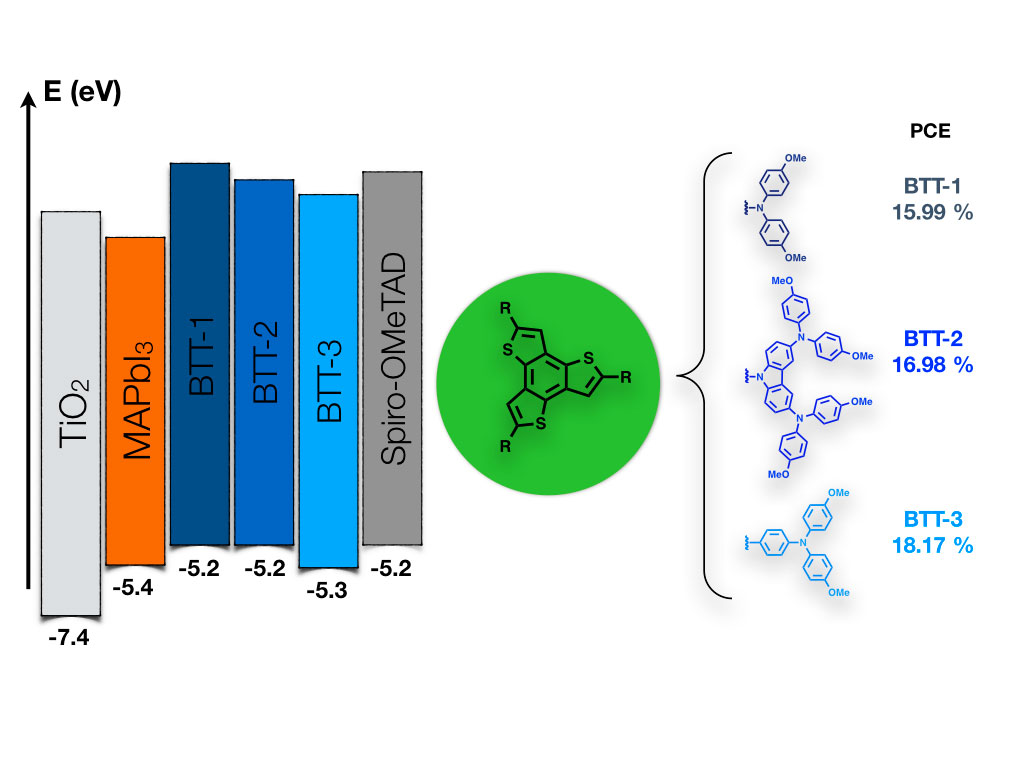
Encouraged by this extraordinary results we explored the isomerism effect on the photovoltaic properties. To this end we described the synthesis, characterization and photovoltaic performance of the new three-armed BTT-4 and four-armed BTT-5 HTMs based on the isomeric forms of BTT bearing p-methoxytriphenylamines. The new materials have been implemented in PSCs, displaying remarkable efficiencies up to 19.0%.
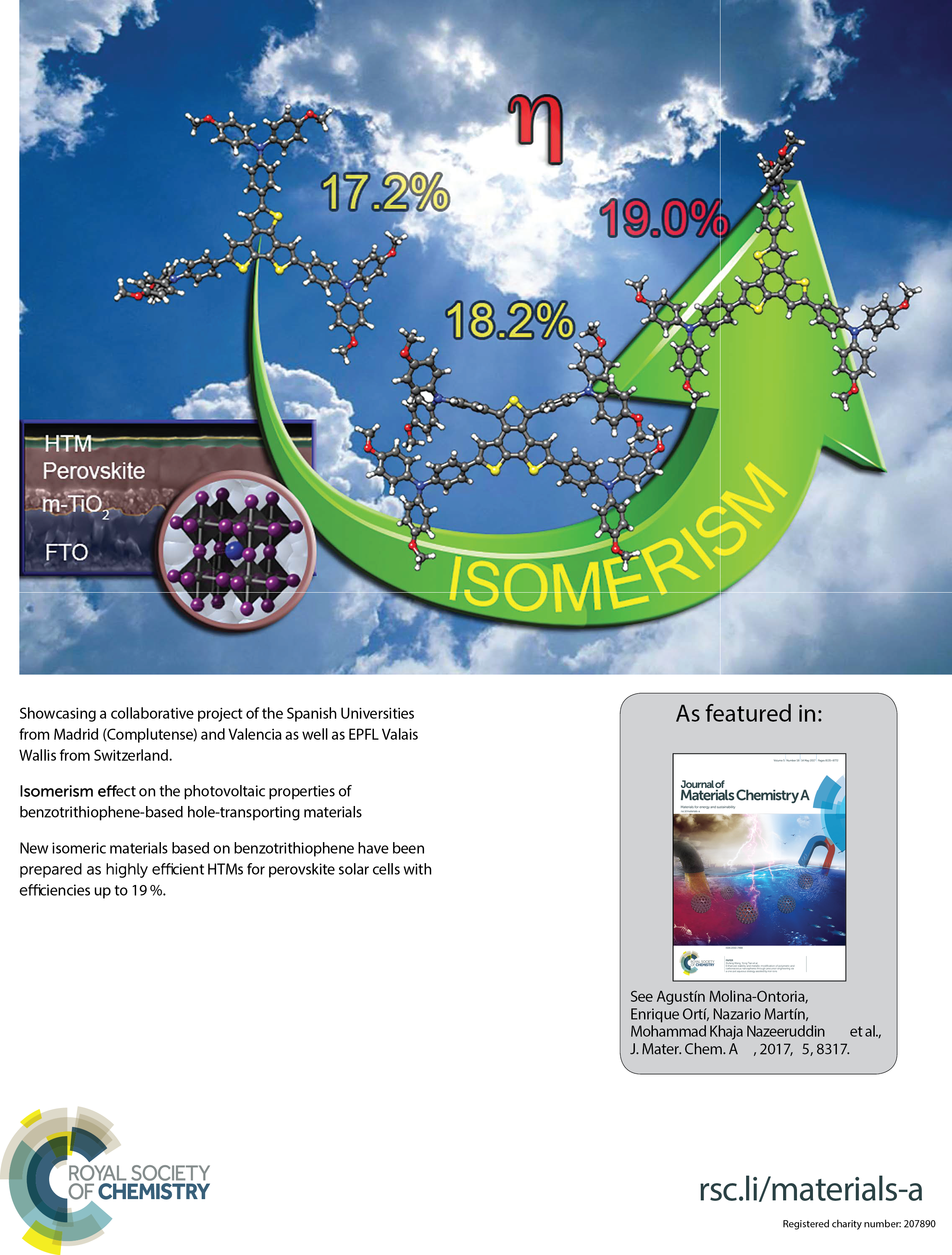
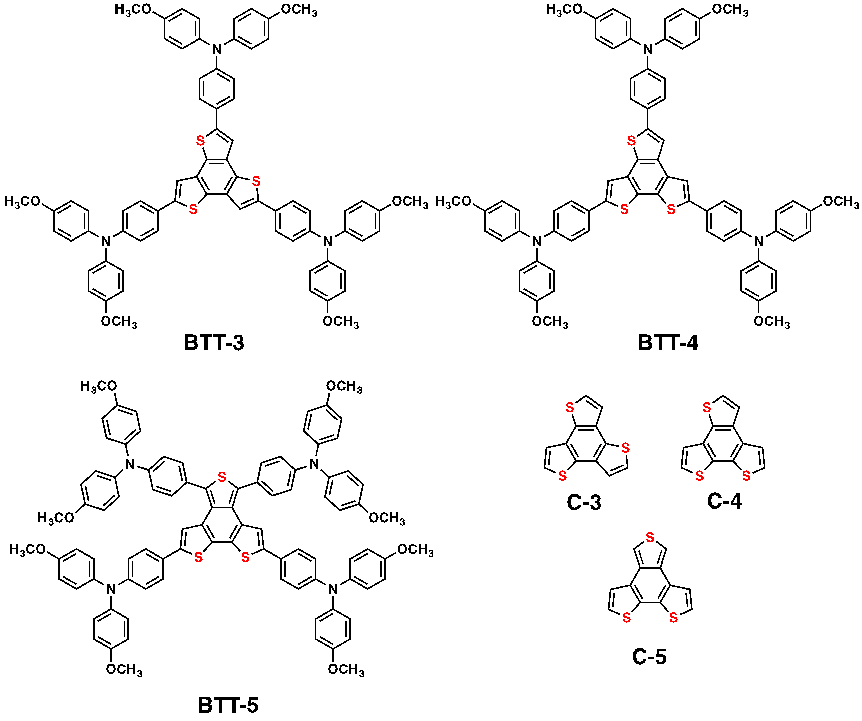
Combining different chemical approaches to tailor potential candidates, we reported the design, synthesis, characterization, and photovoltaic performance of a new family of easily attainable HTMs based on an anthra[1,2-b:4,3-b′:5,6-b″:8,7-b′′′]tetrathiophene (ATT) core endowed with p-alkoxytriphenylamines of different alkyl chain length. ATT is a sulfur-rich polycyclic aromatic hydrocarbon with a flat and rigid π-conjugated structure, which consists of four thiophene units fused to an anthracene.
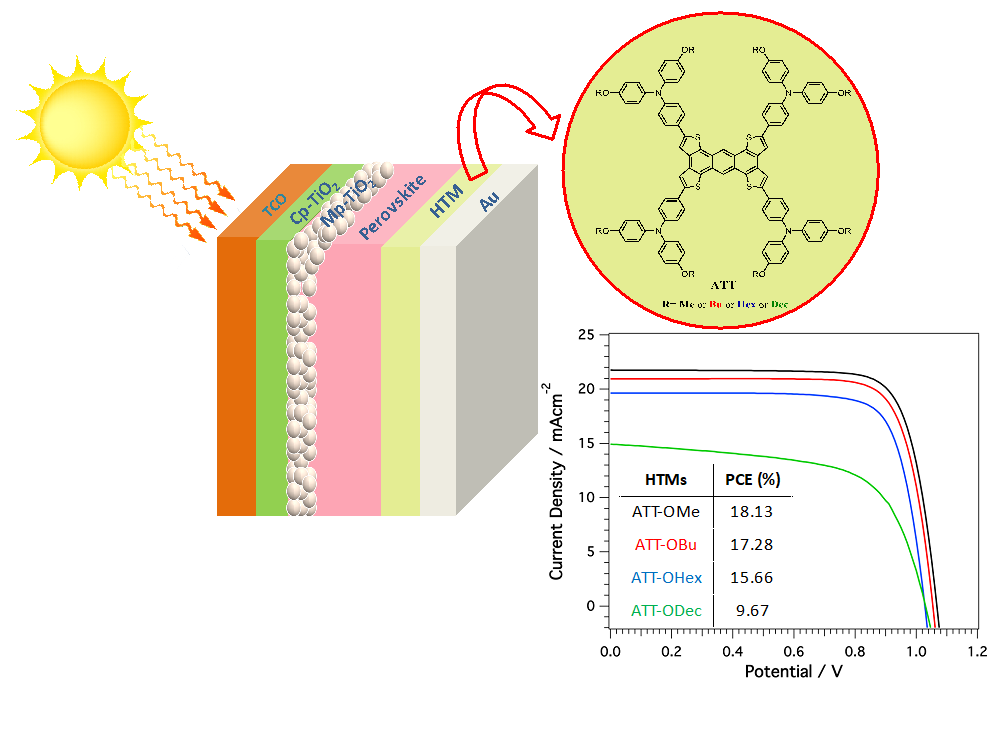
Inspired by these findings, we presented two new HTMs, in which the π-conjugation of the central core has been systematically modulated. Particularly important in this design is to control the molecular packing by introducing highly planar structures, which is an important parameter for enhancing carrier mobilities. Promoting the intermolecular assembly by π−π and S···S interactions serves as a powerful paradigm for the design of more efficient HTMs. On this basis, we have synthesized two novel sulfur-rich cores, dibenzoquinquethiophene (DBQT) and dibenzosexithiophene (DBST), to which four triphenylamine (TPA) units are attached at the α- position of the four terminal thiophene rings giving rise to the tetrakistriphenylamine (TTPA) derivatives with power conversion efficiencies of up to 18.1%.
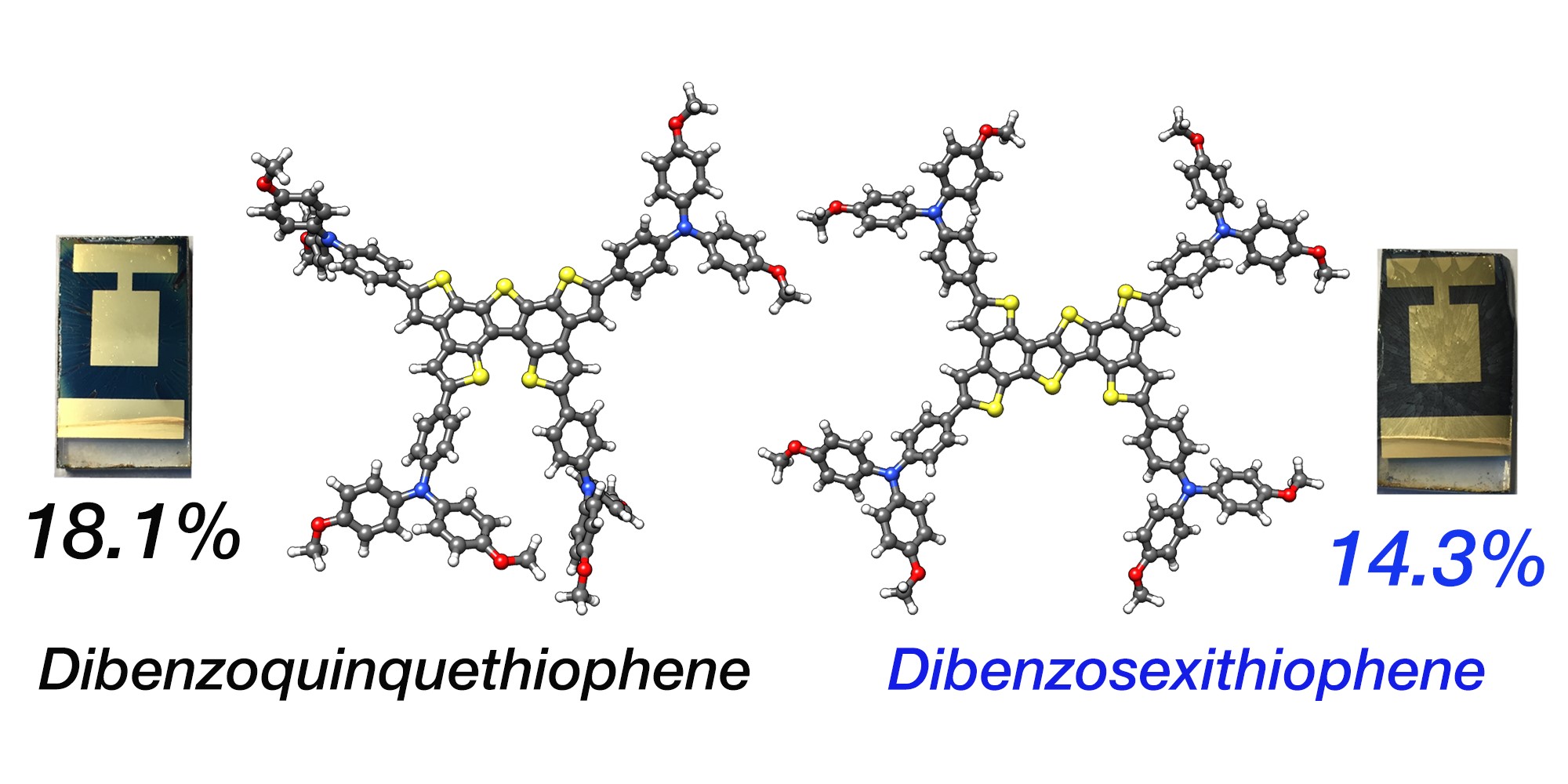
With an eye toward carrying out a complete and systematic study of the impact that the molecular structure of the HTM has on the photovoltaic properties of PSCs, we explored the photovoltaic performance of three new three-armed sulfur-free HTMs. The new derivatives show C3 symmetry with three pyrrole (BTP-1), furan (BTF-1), or selenophene (BTSe-1) rings fused to a benzene central ring, and are isostructural to our previously reported BTT-3 compound that bears three thiophene rings. The new HTMs show remarkable efficiencies comparable to those reported for devices using the state-of-the-art spiro-OMeTAD and higher than those obtained for the isostructural BTT-3.
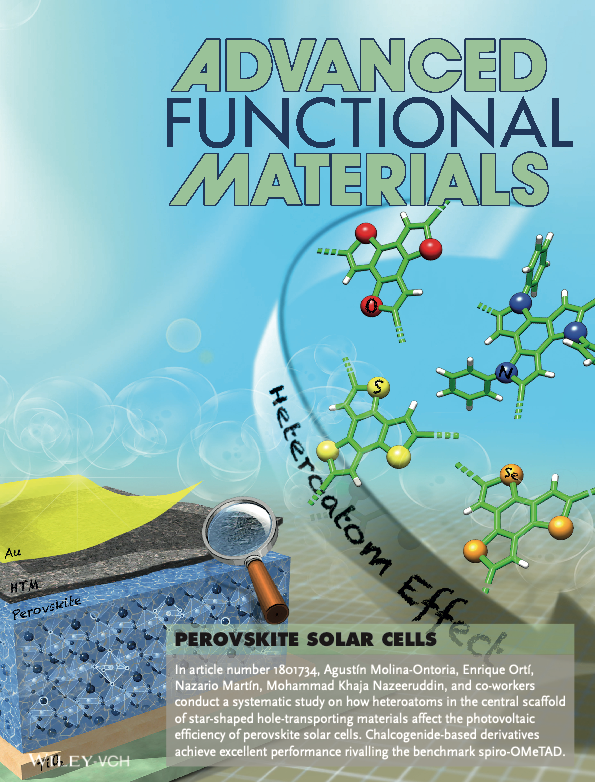
Electron rich molecules like benzodithiophene (BDT) and dithienopyrrole (DTP) have been widely employed in organic photovoltaics with varying degrees of success. These two building-blocks offer structural elements, like having large p-conjugated surfaces and the presence of heteroatoms, which help promoting intermolecular interactions. The PSCs fabricated making use of these two materials as HTLs show efficient charge transport to the electrodes which allows obtaining photocurrent conversion efficiencies (PCEs) over 18%.
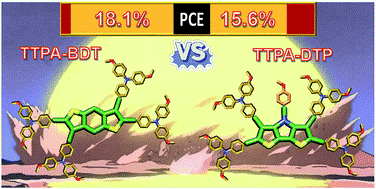
Recently we have published a review paper in which the scope refers to the main classes of small organic molecules used as Hole Transporting Materials (HTMs) for perovskite solar cells. Furthermore, strategies and reaction types that chemists have used to construct a huge number of modified chemical structures with the ultimate goal of enhancing the device performance are specifically considered. Preparation of HTMs requires, however, rational chemical synthesis to obtain suitable materials for the fabrication of devices.
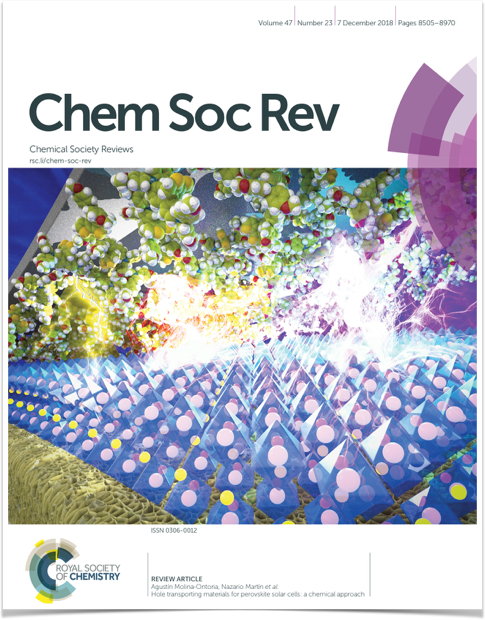
Electron-Tranporting Materials (ETMs)
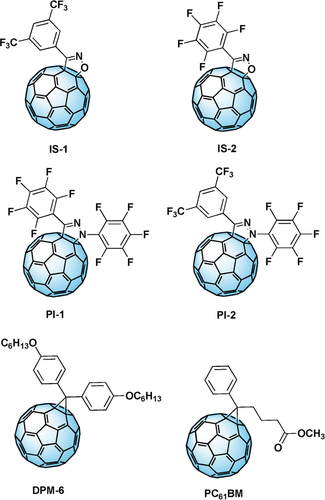
Titanium dioxide is often the material of choice as electron-transport material (ETM) in regular PSCs. The titanium dioxide used in these solar cells needs generally a sintering process, which requires treatment at high temperatures. This thermal treatment implies a drawback in energy cost for future commercialization of these devices. Moreover, the use of titanium dioxide influences the rigid morphology of the cell, limiting its use on curved surfaces. Thus, replacement of TiO2 as ETM by organic materials is a very important subject for the suitable development and future commercialization of PSCs.
We analyzed different fullerene derivatives as ETMs. In this regard, the fullerene derivatives have been functionalized with a carboxyl group (−COOH), which is a widely employed functional group for anchoring to the TiO2 surface. To this end, we introduced two cyanide groups in the fullerene moiety, which significantly modify the reduction potential values of the molecule and provide further anchoring group through the lone pair nitrogen atoms.
We have also explored a variety of novel and well-known fullerene derivatives (DPM-6, PC61BM) showing different electron-accepting capabilities and studied the effect over the photovoltaic performance of electron transport layer (ETL)-free solar cells based on perovskite/fullerene blends. In particular, 14.3% power conversion efficiency was obtained for the ETL-free perovskite solar cells (PSCs) based on CH3NH3PbI3/isoxazolino[60] derivative blend films. The photovoltaic performance improvement, in comparison to devices based on CH3NH3PbI3/[60]fullerene blend films and [70]fullerene analogues, demonstrates the beneficial impact of the fullerene chemical modification.

We have also reported an alternative and highly efficient methodology based on mild conditions to obtain [70]methanofullerenes PCBM-like derivatives that allows us to direct the site-selectivity of the cycloaddition to the alpha or to the beta isomer, depending on the solvent polarity. This approach enables to obtain substantial amounts of both a and b-site-isomers. This new set of pure [70]fullerene derivatives was applied as interface passivation materials in PSCs in order to determine the isomer effect on the photovoltaic properties. The positive influence of the [70]fullerenes by passivating the voids/pin-holes and/or deep slits, is reflected in highly efficient and stable bulk heterojunction perovskite solar cells, whose performance (around 20%) is slightly but consistently depending on the isomeric fullerene composition. These experimental findings pave the way to investigate a new reactivity on C70 and to explore the properties of the less-known β-derivatives.
